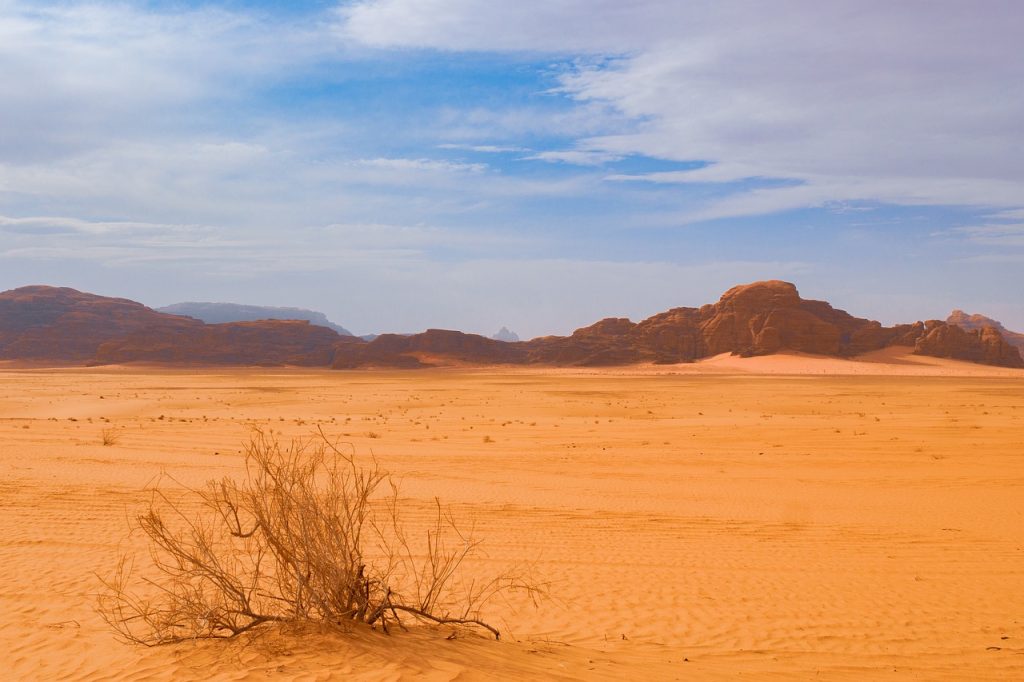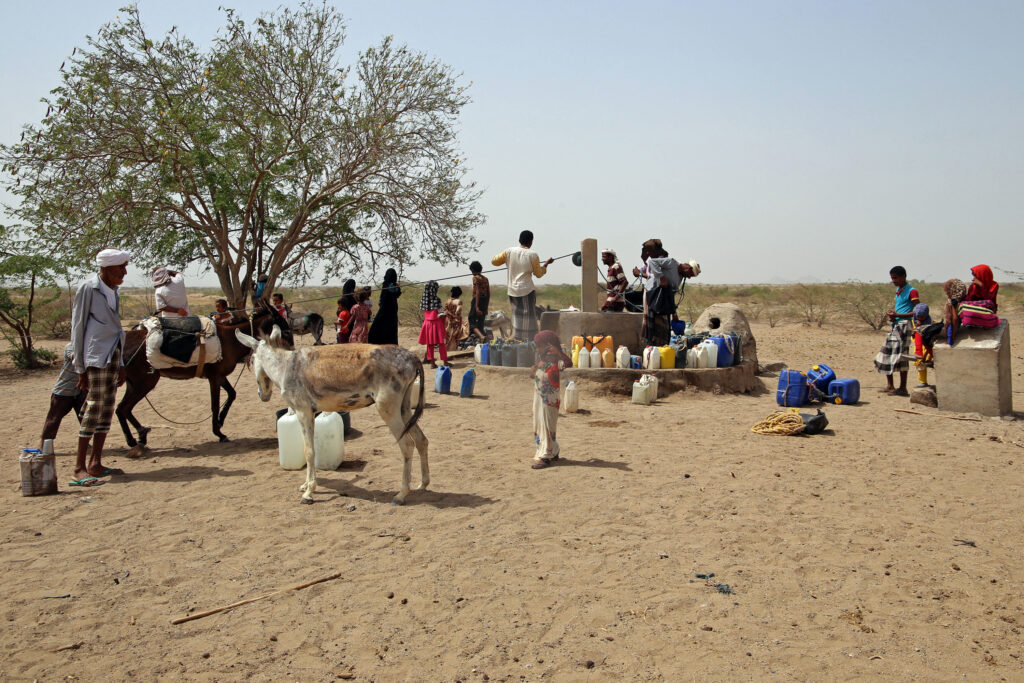By Aisha Al-Sarihi
Climate change is expected to greatly affect the Middle East region, with lower rainfall, increased temperatures, and more frequent extreme events, such as flash floods. Over the past three decades, temperatures in the region have risen by 1.5 degrees Celsius — twice the global norm of 0.7 degrees Celsius – and climate models estimate a continuous rise towards the end of the century. The region has already witnessed some of the highest recorded temperatures in the world: 54°C in Kuwait, and 53.9°C in Basra in Iraq, in 2016. Rainfall has become more variable, and climate disasters such as droughts and floods more frequent[1]. Extreme weather events such as cyclones and dust storms have increased in frequency and intensity over the region. Examples include Cyclones Guno (2007), Chapala (2015), Sagar (2018), Gati (2020), Shaheen (2021), to name a few[2].
The physical effects of climate change on already-scarce resources like water and food will exacerbate existing tensions or create new ones, such as urban migration and social unrest. These tensions will not only be felt within countries, but will spill across borders, with implications for regional security. That is because Middle Eastern and North African countries share natural resources. For instance, over 66 per cent of freshwater resources in Middle Eastern states originate from outside of their national borders.
Such risks are likely to manifest faster and more clearly in lower-income, fragile, and conflict-affected countries, which have already displayed low climate resilience. In Iran, for example, social unrest has been simmering, with occasional protests breaking out, including in Khuzestan province in 2021, when severe water shortages and electricity blackouts[3] sparked violence. Climate change could also lead to increased urban migration and competition between communities over resources. In 2021, droughts in northern Iraq led to poor harvests, causing food prices to rise and a reduction in income, exacerbating existing vulnerabilities and threatening food and livelihood security[4].
Water scarcity has also driven some internal conflicts. In Yemen, a conflict between two neighbouring villages near the city of Taiz in 2013 erupted because of competition over a water well, resulting in two people being killed. As of 2019, more than 62 per cent of Taiz’ population of over 2.5 million were unable to access potable water. Likewise, protests over the right to drinking water erupted in Zagora in southern Morocco in 2017.[5]
Perhaps the best examples of unrest are the drought that caused food prices to spike in Tunisia in 2011,[6]sparking demonstrations that eventually spread throughout the region and came to be known as the Arab Spring, as well the Syrian civil war, which grew out of an extended drought which affected wheat and cotton production, unleashing social unrest.[7]
In addition, the impacts of climate change on natural ecosystems can be felt across borders[8]. Examples of the negative trans-boundary effects of climate change in the Arab region include tension over water resources. Fourteen of the 22 Arab states share a surface water body. There is a growing concern that climate change may act as a catalyst by aggravating water scarcity and tensions within and between nations sharing water resources.
There are already signs of brewing trans-boundary conflicts over shortages in shared water resources. The growing tensions between Egypt, Sudan, and Ethiopia over the Grand Ethiopian Renaissance Dam in the section of the Blue Nile which courses through the country are perhaps the biggest challenge. Egypt fears the dam will reduce water flow downstream, and there are concerns the conflict could escalate into a war[9].
Another notable example is the Tigris and Euphrates, where Turkey and Iran control much of the water flow into Syria and Iraq. The Euphrates flows from Turkey through Syria before entering Iraq, where it joins the Tigris and forms the Shatt al-Arab, which empties into the Persian Gulf. The Tigris basin shares the same political boundaries, but adds Iran as a fourth riparian country. Trans-boundary water management is thus generating friction between Turkey and Iran[10]. In May 2022, for instance, Iranian Foreign Minister Hossein Amirabdollahian and a number of MPs blamed Ankara’s ambitious dam-building projects for increased drought in Iraq and Syria, and more frequent dust storms in Iran, calling Turkey’s approach “unacceptable”. Turkey, for its part, refuted the Iranian claims as unscientific, and instead accused Tehran’s policymakers of trying to turn Ankara into a scapegoat to deflect public attention away from the regime’s mismanagement of the country’s water resources.[11]
Another example is the Jordan River System (JRS), which is of great importance to Jordan, the Palestinian Territories and Israel. The river suffers from over-extraction, severe pollution, and salinity problems. Considerable dam construction and diversions for agriculture have in effect stopped the river’s natural flow, which plummeted from 1.3 billion m3 annually to just 100 million m3. This has several severe environmental and social consequences, including the formation of sink holes and retreating sea levels. Tensions between Israel and its Arab neighbours have been an issue since 1948, limiting any regional cooperation over shared waters between states. Progress, however, has been observed since 1994, when Jordan signed a peace agreement with Israel[12] which included clauses on water-sharing as well as mutual protection of water quality, and the establishment of joint institutional bodies such as the Joint Water Committee and Regional Water Data Banks project. The signing of Abraham Accords in 2020 has also prompted further regional cooperation over shared resources, including the signing of an energy-for-water deal between Jordan and Israel overseen by the UAE.
In the Middle East, while how climate change could exacerbate national and regional security has not received sufficient attention, a number of regional security-related strategies and initiatives have been developed and put in place to mitigate possible competition and tension between communities over scarce resources. For instance, the importance of water security has been recognised in the Arab Ministerial Water Council’s Water Security Strategy. Adopted in 2011, this strategy lays out a joint framework for action to tackle water security challenges facing the Middle East and North Africa region. Its priorities include raising water productivity, adopting integrated water policies, and developing non-conventional water resources, including recycled and desalinated water.[13]
At its 31st Summit in Abu Dhabi in December 2010, the Gulf Cooperation Council’s (GCC) Supreme Council acknowledged the importance of addressing the sustainability of water sector. The “Abu Dhabi Declaration” accorded this the highest priority. In 2016, the GCC Secretariat General formed the GCC Unified Water Strategy 2016-2035 (GCC UWS 2035)[14], which was endorsed as an overall guiding strategy for the grouping’s national water plans. A major milestone in the Council’s efforts to tackle water scarcity, this strategy aims to establish a “sustainable water sector management system” in each GCC country by securing long-term supplies while meeting strict criteria for socio-economic, financial, and environmental sustainability and public health requirements.[15]
The Middle East is expected to warm twice as fast as the rest of the world, and precipitation trends are likely to fall further in an already water-stressed region. Tensions over shared resources will thus not be limited to the examples highlighted. Without timely and effective intervention, climate-related security threats will be repeated in other places across the region. Policymakers must build proper understanding of the threats presented by climate change, and consequently foster regional cooperation and climate diplomacy in areas that are not only restricted to water resources. They must also understand that the traditional solutions to peace and security will not be inclusive or enough without considering the issues of climate change. Importantly, regional cooperation efforts, such as the examples highlighted, must go beyond embarking on initiatives and strategies and focus on implementation, setting aside disputes and differences and incorporating as many stakeholders as possible.
Image Captions: A photo of drought in desert Wadi Rum, Jordan. Photo by: Pixabay
About the Author
Dr Aisha Al-Sarihi’s areas of research expertise and interest include clean energy policy and climate economics, policies and governance, with a focus on the Arab region.
Following her PhD, from 2016 to 2017, she was a research officer at the London School of Economics and Political Science’s Middle East Centre. She was also a former visiting scholar at Arab Gulf States Institute in Washington (2017) and Georgetown University’s Center for Contemporary Arab Studies (2018). Before joining MEI, Dr Al-Sarihi was a research associate in the Climate and Environment Program at King Abdullah Petroleum Studies and Research Center (KAPSARC) from 2019 to 2021.
She holds a PhD from the Centre for Environmental Policy at Imperial College London and a MSc and a BSc, with distinction, in environmental science from Sultan Qaboos University.
[1] Jihad Azour and Christoph Duenwald. 2022. Without Adaptation, Middle East and Central Asia Face Crippling Climate Losses. IMF Blog. https://blogs.imf.org/2022/03/30/without-adaptation-middle-east-and-central-asia-face-crippling-climate-losses/
[2] See, for example, Evan, A. T; Camargo, S. J. 2011. A Climatology of Arabian Sea Cyclonic Storms. Journal of Climate; Deshpande, M., Singh, V.K., Ganadhi, M.K. et al. Changing status of tropical cyclones over the north Indian Ocean. Climate Dynamics. 57, 3545–3567 (2021). https://doi.org/10.1007/s00382-021-05880-z.; Al-Manji, S., Mitchell, G., Ruheili, A. A. , 2021, ‘Arabian Sea Tropical Cyclones: A Spatio-Temporal Analysis in Support of Natural Hazard Risk Appraisal in Oman’, in R. S. Meena (ed.), Agrometeorology, IntechOpen, London. 10.5772/intechopen.96961; قبل هيكا: تفاصيل عن أعاصير عديدة مرّت على السلطنة بينها اثنان تشابها في يوم وقوعهما
: https://www.atheer.om/archives/507313/%d9%82%d8%a8%d9%84-%d9%87%d9%8a%d9%83%d8%a7-%d8%aa%d9%81%d8%a7%d8%b5%d9%8a%d9%84-%d8%b9%d9%86-%d8%a3%d8%b9%d8%a7%d8%b5%d9%8a%d8%b1-%d8%b9%d8%af%d9%8a%d8%af%d8%a9-%d9%85%d8%b1%d9%91%d8%aa-%d8%b9%d9%84/#ixzz7Zl2l72op
[3] Jack Goodman. 2021. Iran water: What’s causing the shortages? BBC Reality Check https://www.bbc.com/news/58012290
[4] SIPRI, Katongo Seyuba, Kheira Tarif, Dr. Kyungmee Kim, Dr. Dylan O’Driscoll, Shivan Fazil; NUPI, Dr. Elisabeth L. Rosvold, Anne Funnemark. Visuals: Kheira Tarif & Jose Luengo-Cabrera. Design: Winkel AS. 2022. Climate, Peace and Security Fact Sheet: Iraq. Available at: https://www.sipri.org/sites/default/files/NUPI_Fact_Sheet_Iraq_April2022_new[46].pdf
[5] Amro Selim. 2021. Regional Water Cooperation in the Middle East and North Africa: Transitioning from Conflict to Stability. Fikra Forum. https://www.washingtoninstitute.org/policy-analysis/regional-water-cooperation-middle-east-and-north-africa-transitioning-conflict
[6] Perez, Ines. 2013. “Climate Change and Rising Food Prices Heightened Arab Spring.” Scientific American 4
(3).
[7] Marwa Daoudy. 2020. The Origins of the Syrian Conflict: Climate Change and Human Security (Cambridge University Press, 2020)
[8] Al-Sarihi, A. and Luomi, M. 2019. Climate Change Governance and Cooperation in the Arab Region. EDA Insight: New Governance for the Environment in the Arab Region Series. Emirates Diplomatic Academy.
[9] Aljazeera. 2022. Ethiopia starts electricity production at Blue Nile mega-dam. https://www.aljazeera.com/news/2022/2/20/ethiopia-electricity-production-gerd-blue-nile-mega-dam
[10] Jakob Granit and Rebecca Löfgren. 2010. Water and Energy Linkages in the Middle East: Regional Collaboration. Opportunities. SIWI Paper 16, Stockholm International Water Institute (SIWI).
[11] Nima Khorrami. 2022. Amid dust storms and drought, Turkey and Iran are at odds over transboundary water management. Middle East Institute. Washington DC. https://mei.edu/publications/amid-dust-storms-and-drought-turkey-and-iran-are-odds-over-transboundary-water
[12] Jordan and Israel: Tensions and Water Cooperation in the Middle-East. Climate Diplomacy. https://climate-diplomacy.org/case-studies/jordan-and-israel-tensions-and-water-cooperation-middle-east
[13] Technical Secretariat of the Arab Ministerial Water Council (2012). Arab Strategy for Water Security in the Arab Region – To Meet the Challenges and Future Needs for Sustainable Development 2010-2030. Arab Ministerial Water Council, Cairo, Egypt. https://www.unescwa.org/sites/default/files/event/materials/arab_strategy_for_water_security-english_translation-2012_0.pdf
[14] Zubari, Waleed & Al-Turbak, Abdulaziz & Zahid, Walid & Al-Ruwis, Khalid & Al-Tkhais, Ali & Al-Mutaz, Ibrahim & Abdelwahab, Ahmed & Murad, Ahmed & Al-Harbi, Meshari & Al-Sulaymani, Zaher. (2017). An overview of the GCC Unified Water Strategy (2016-2035). DESALINATION AND WATER TREATMENT. 81. 1-18. 10.5004/dwt.2017.20864.
[15] Waleed Khalil Al-Zubari. Challenges to Water Resources Sustainability in the GCC Countries. Gulf Centre for Development Policies.





